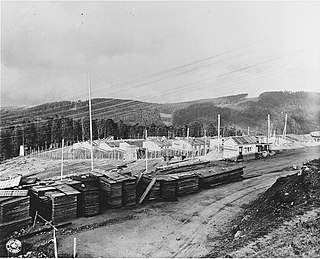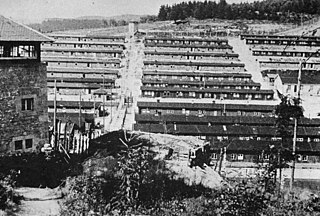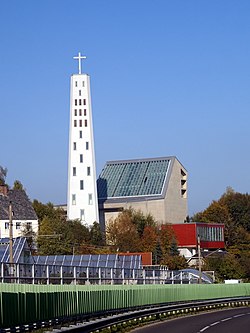
Auschwitz concentration camp was a complex of over 40 concentration and extermination camps operated by Nazi Germany in occupied Poland during World War II and the Holocaust. It consisted of Auschwitz I, the main camp (Stammlager) in Oświęcim; Auschwitz II-Birkenau, a concentration and extermination camp with gas chambers; Auschwitz III-Monowitz, a labour camp for the chemical conglomerate IG Farben; and dozens of subcamps. The camps became a major site of the Nazis' Final Solution to the Jewish question.

Natzweiler-Struthof was a Nazi concentration camp located in the Vosges Mountains close to the villages of Natzweiler and Struthof in the Gau Baden-Alsace of Germany, on territory annexed from France on a de facto basis in 1940. It operated from 21 May 1941 to September 1944, and was the only concentration camp established by the Germans in the territory of pre-war France. The camp was located in a heavily forested and isolated area at an elevation of 800 metres (2,600 ft).

Flossenbürg was a Nazi concentration camp built in May 1938 by the SS Main Economic and Administrative Office. Unlike other concentration camps, it was located in a remote area, in the Fichtel Mountains of Bavaria, adjacent to the town of Flossenbürg and near the German border with Czechoslovakia. The camp's initial purpose was to exploit the forced labor of prisoners for the production of granite for Nazi architecture. In 1943, the bulk of prisoners switched to producing Messerschmitt Bf 109 fighter planes and other armaments for Germany's war effort. Although originally intended for "criminal" and "asocial" prisoners, after Germany's invasion of the Soviet Union, the camp's numbers swelled with political prisoners from outside Germany. It also developed an extensive subcamp system that eventually outgrew the main camp.

Mauthausen was a German Nazi concentration camp on a hill above the market town of Mauthausen, Upper Austria. It was the main camp of a group with nearly 100 further subcamps located throughout Austria and southern Germany. The three Gusen concentration camps in and around the village of St. Georgen/Gusen, just a few kilometres from Mauthausen, held a significant proportion of prisoners within the camp complex, at times exceeding the number of prisoners at the Mauthausen main camp.

Aufseherin was the position title for a female guard in Nazi concentration camps. Of the 50,000 guards who served in the concentration camps, training records indicate that approximately 3,500 were women. In 1942, the first female guards arrived at Auschwitz and Majdanek from Ravensbrück. The year after, the Nazis began conscripting women because of a shortage of male guards. In the context of these camps, the German position title of Aufseherin translates to (female) "overseer" or "attendant". Later female guards were dispersed to Bolzano (1944–1945), Kaiserwald-Riga (1943–44), Mauthausen, Stutthof (1942–1945), Vaivara (1943–1944), Vught (1943–1944), and at Nazi concentration camps, subcamps, work camps, detention camps and other posts.

Maria Mandl was an Austrian SS-Helferin and a war criminal known for her role in the Holocaust as a top-ranking official at the Auschwitz-Birkenau extermination camp, where she is believed to have been directly complicit in the deaths of over 500,000 prisoners. She was executed for war crimes.

From 1933 to 1945, Nazi Germany operated more than a thousand concentration camps, including subcamps on its own territory and in parts of German-occupied Europe.

The Lenzing Group is an international group with its headquarters in Lenzing, Austria, and production sites in all major markets. Lenzing produces wood-based viscose fibers, modal fibers, lyocell fibers and filament yarn, which are used in the textile industry — in clothing, home textiles and technical textiles — as well as in the nonwovens industry. In addition, the company is active in mechanical and plant engineering. The Lenzing Group markets its products under the brand names TENCEL, VEOCEL, LENZING ECOVERO and LENZING.
The Jaworzno concentration camp was a concentration camp in WW2, German-occupied Poland and later in Communist Poland. It was first established by the Nazis in 1943 during the Second World War and was later used by the Soviet NKVD in 1945 to 1956. After that it was used by the Ministry of Public Security and other agencies of the Polish communist regime. Today the site is an apartment complex and also houses a memorial to the camp's victims.

Gunskirchen is a town in the Austrian state of Upper Austria.

Monowitz was a Nazi concentration camp and labor camp (Arbeitslager) run by Nazi Germany in occupied Poland from 1942–1945, during World War II and the Holocaust. For most of its existence, Monowitz was a subcamp of the Auschwitz concentration camp; from November 1943 it and other Nazi subcamps in the area were jointly known as "Auschwitz III-subcamps". In November 1944 the Germans renamed it Monowitz concentration camp, after the village of Monowice where it was built, in the annexed portion of Poland. SS Hauptsturmführer (Captain) Heinrich Schwarz was commandant from November 1943 to January 1945.

Ebensee was a subcamp of Mauthausen concentration camp established by the SS to build tunnels for armaments storage near the town of Ebensee, Austria, in 1943. The camp held a total of 27,278 male inmates from 1943 until 1945. Between 8,500 and 11,000 prisoners died in the camp, most from hunger or malnutrition. Political prisoners were most common, and prisoners came from many different countries. Conditions were poor, and along with the lack of food, exposure to cold weather and forced hard labor made survival difficult. American troops of the 80th Infantry Division liberated the camp on 6 May 1945.

Sankt Georgen an der Gusen is a small market town in Upper Austria, Austria, between the municipalities of Luftenberg and Langenstein. As of 2015, the town had 3,779 inhabitants.
Malchow was one of the numerous sub-camps of Nazi concentration camp: Ravensbrück, located in Germany, which is believed to be first opened in the winter of 1943. It was located at Malchow in Mecklenburg.
Freiberg was a subcamp of Flossenbürg concentration camp located in Freiberg, Saxony.
The Fürstengrube subcamp was a subcamp of the Auschwitz concentration camp, operated by Nazi Germany in 1943–1945 in Wesoła near Mysłowice in occupied Poland.
Lotte Toberentz, born Maria Charlotte Toberentz was the head overseer of the Uckermark concentration camp for girls, a subcamp of Ravensbrück concentration camp, in its early years. From December 1944 to April 1945 she was Lagerführerin of the Ravensbrück concentration camp.
Kazimierz Smoleń was a Polish political prisoner of the Nazi World War II KZ Auschwitz, and later a long-term director of Auschwitz-Birkenau State Museum.

During World War II, the German Luftwaffe staffed dozens of concentration camps, and posted its soldiers as guards at many others. Camps created for the exploitation of forced labor for armaments production were often run by the branch of the Wehrmacht that used the products. The Wehrmacht also posted about 10,000 soldiers to concentration camps because of a shortage of guards in mid-1944, including many from the Luftwaffe.

Gusen was a subcamp of Mauthausen concentration camp operated by the SS between the villages of Sankt Georgen an der Gusen and Langestein in the Reichsgau Ostmark. Primarily populated by Polish prisoners, there were also large numbers of Spanish Republicans, Soviet citizens, and Italians. Initially, prisoners worked in nearby quarries, producing granite which was sold by the SS company DEST.
















